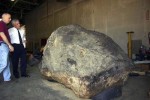Well, on paper anyway. Kentucky settled its lawsuit against Portsmouth, Ohio, and the Indian Head Rock will return to the motherland across the river.
An Agreed Order between the Commonwealth of Kentucky and the city of Portsmouth, Ohio, its former mayor Gregory Bauer, Steven Shaffer and David Vetter, dismissing the civil suit, was filed Thursday in federal district court.
As part of the settlement, the city of Portsmouth will relinquish custody and control of the artifact and permit its transport to a location designated by the Kentucky Heritage Council, an agency responsible for the identification, protection and preservation of the state’s archaeological and historic resources. No date has yet been set for its return, but the exchange is expected to take place over the next few weeks.
Blind justice has spared the man who absconded with the rock in the first place, Ohio historian Steven Shaffer. In June of 2008, a Kentucky grand jury indicted him for felony removal of an antiquity. The case wound its way through the system for a year, then Shaffer’s attorney argued persuasively that they couldn’t prove the rock Shaffer took was the official protected Indian Head Rock. There are several other boulders known by that nickname and the official records are apparently unclear, so on July 30, 2009, a judge dismissed the charges.
 This lawsuit and a few legislative barbs are all that’s left of Kentucky’s mighty arsenal of dudgeon. They’re getting the rock back and they’re happy about it. People have volunteered to help move the eight-ton boulder so the rock will be returned at little expense to the taxpayer. It won’t go back to the river, though, because obviously the site has original been compromised. Officials are contemplating creating a special display for the rock to be properly conserved, studied and displayed to the public.
This lawsuit and a few legislative barbs are all that’s left of Kentucky’s mighty arsenal of dudgeon. They’re getting the rock back and they’re happy about it. People have volunteered to help move the eight-ton boulder so the rock will be returned at little expense to the taxpayer. It won’t go back to the river, though, because obviously the site has original been compromised. Officials are contemplating creating a special display for the rock to be properly conserved, studied and displayed to the public.
This wacky caper is probably the greatest thing that could have happened to the boulder. It was a carving rock, steamboat marker and popular picture-taking spot in the late 1800s and early 1900s. But when the Ohio river was dammed in the 20s, the rock was submerged under 16 feet of water where it remained until divers found it again earlier this decade. Those divers were led by none other than Steven Shaffer, who would later heist it on out of there.